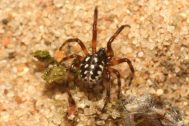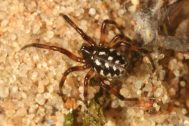Heterogeneity of environmental conditions is the crucial factor supporting biodiversity in various habitats, including post-mining sites. The effects of micro-topographic heterogeneity on biodiversity and conservation potential of arthropod communities in post-industrial habitats had not been studied before now. At one of the largest European brown coal spoil heaps, we sampled eight groups of terrestrial arthropods with different life strategies (moths, spiders, ground beetles, ants, orthopteroids, centipedes, millipedes, and woodlice), in successionally young plots (5–18 y), with a heterogeneous wavy surface after heaping, and compared the communities with plots flattened by dozing. A combination of the standardized quantitative sampling, using two different methods, and a paired design of the plot selection enabled a robust analysis. Altogether, we recorded 380 species of the focal arthropods, 15 of them nationally threatened. We revealed the importance of the microtopographic heterogeneity for the formation of the biodiversity of arthropods in their secondary refuges. The communities with higher biodiversity and conservation value were detected in the plots with heterogeneous surfaces; exceptions were ground beetles and millipedes. The surface flattening, often the first step of technical reclamation projects, thus suppress biodiversity of most terrestrial arthropods during the restoration of post-mining sites. Since the communities of both surface types differed, the proportional presence on both surfaces could be more efficient in supporting the local biodiversity. We suggest reducing the surface dozing for the cases with other concerns only, to achieve a proportional representation of both surface types. Such a combination of different restoration approaches would, thus, efficiently support high biodiversity of groups with various needs.















